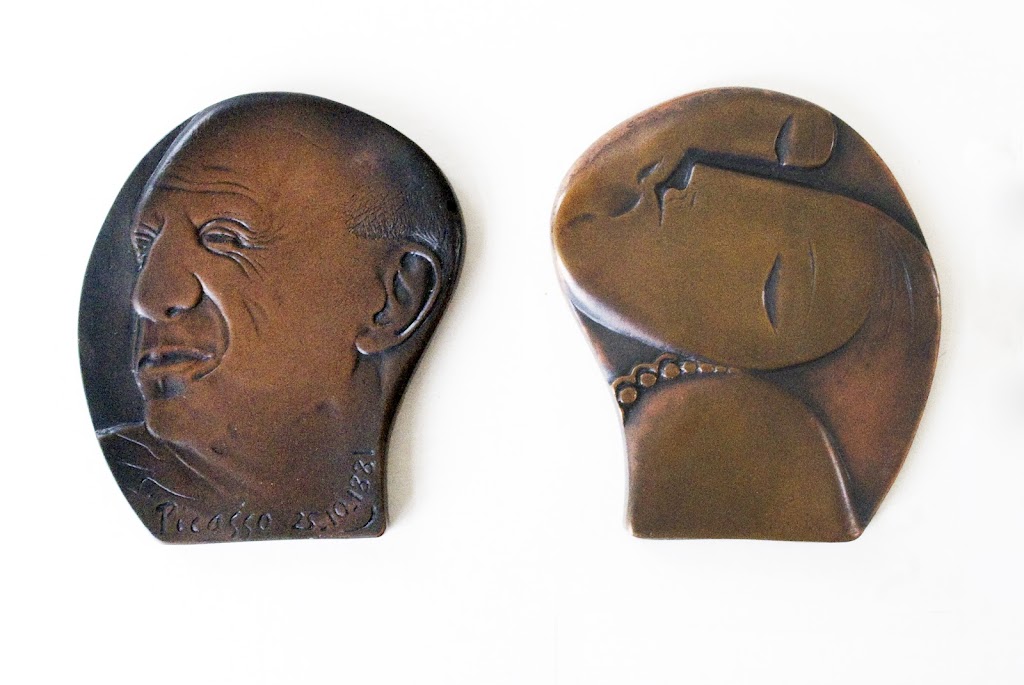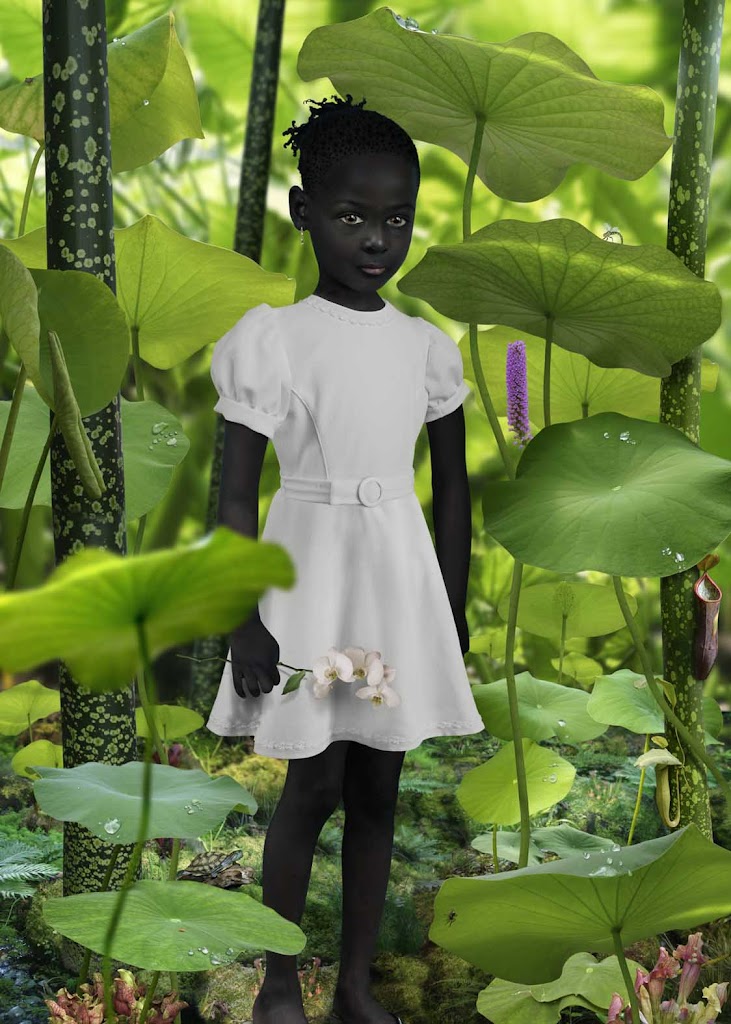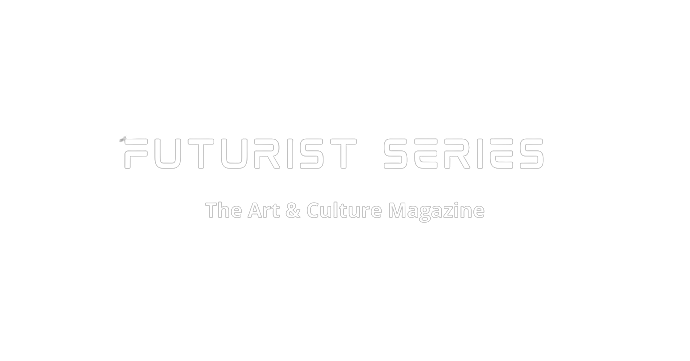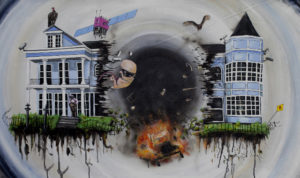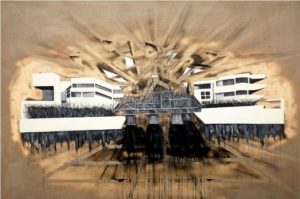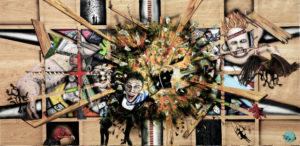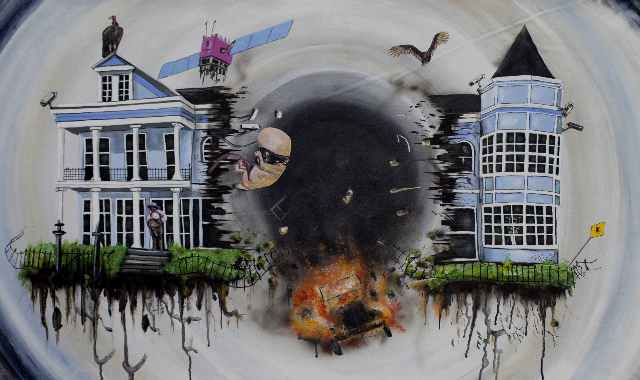
Science, Skin, and D.N.A. Pabi Chulo in conversation with Sheeka Arbuthnot
This interview is part of an ongoing conversation about the future of art, the responsibility of the artist, and the systems within which we function and fight between the artist and interviewer.
The Getty Getaway, 2012. Acrylic and spray paint on raw linen canvas. 40”x 65”
Sheeka Arbuthnot: Pabi, I would like to begin with a question that deals with geographic displacement. Can you tell me how your experience here in San Francisco has impacted your practice?
Pabi Chulo: Yes, I came here to San Francisco in August, 2011. Being a part of a creative and educational institution is very stimulating and sometimes also frustrating. Going from a full time professional artist to be at the school bench can be a challenge. But I really enjoy being around people from all around the world, discussing art and being a part of the SF art scene. I have gotten many new ideas here and a broader perspective on contemporary art. Especially contemporary American art. Hopefully, I will create an artistic network with beneficial connections for the rest of my life.
SA: Your media are painting, drawing, performance and video. Can you describe the new medium with which you propose to work (science, skin, DNA) and how you believe this is relevant to art?
PC: To me, great art is the one that takes the first step into the unknown. Leading a way into the future by asking questions about the direction we´re heading, whether it is political, scientific or cultural. Working in many media gives the opportunity to point out these issues in new perspectives. Sometimes, it is best to criticize something with it´s own medicine; like a painting with paint, film with live picture, or science with the newest technology. I see DNA everywhere, in the paint, in the media or in our body. It´s all chemistry and if we can control it we can control the world.
The newest bio-science opens up many of the unknown and endless. We will have all the bricks and we can create whatever we want. The question is, will the next generations be the same as us? Probably not, but what then?
SA: How how will you proceed with this new medium of DNA?
PB: During my research I discovered a technology that makes it possible to print human tissue with living human stem cells.
It is developed by Dr. Anthony Atala from The Wake Forest Institute of Regenerative Machine and the laboratory Organova in San Diego. The science of Dr. Atala has made him the 23th most influential person in the 21th century according to Esquire Magazine (2008.) I have recently contacted him in order to get help for my further project. This December I am having a meeting with a scientist in Denmark who is able to manipulate stem cell in order to code the cell for a specific task. Like being a skin cell.
Watch these movies and you will know more about bioprinting:
SA: How do you place yourself in the context of national identification and your work?
Do you consider yourself a Danish artist? Are there Danish artists that influence you?
PC: Right now I find it very hard to place myself. I´m in between many categories, I guess. Maybe Pabism is the new shit!
I definitely see myself as a Danish artist spiced up with an international touch. I have traveled a lot and I have lived in Berlin, Melbourne, Copenhagen, and now San Francisco. I´m influenced by many artists some of the most known are Bacon, Stelarc, Basquiat, Abramovic and Duchamp. In general, I admire people with strong personalities who can create their own world and make others believe in it.
I also get my inspiration from outside of the art world, like from politics, science and common stupid and natural human behavior.
SA: Can we discuss your paintings for a moment? You currently have a series in which you “blow-up” buildings, perhaps most memorably the Getty Museum in Los Angeles. What inspired this?
PC: In general buildings and houses are to me a symbol of dreams, tradition, and where we find safety. I blow up houses and materials to make people think about their dreams and the way we live, what is necessary for them, and what they can live without. I think we have to redefine many of our future dreams if we want a sustainable world.
The painting you refer to, The Getty Getaway (2012) shows the Getty Museum blown up or ripped apart. Out of the white marble building comes a flying oil platform lifted by the power from the oil pressure. I have used raw linen canvas in order to show the real natural material and structure. I have kept the pallet in a gray scale except for the foundation of gold spray.
This painting was inspired by a trip in February 2012 that I made to The Getty Center. The museum is located in the hills of Brentwood just outside of Los Angeles. What many may not know, is that the museum was founded by an oil mogul: J. Paul Getty (1892-1976.) At his death, J. Paul Getty was one of the wealthiest people in the American history. He was the first to own more than one billion dollars. By creating the Getty Museum, owned and driven by The J. Paul Getty Trust, The Getty Research Institute, The Getty Conservation Institute and the Getty Foundation. The Getty dynasty is now the wealthiest and most powerful organization in the American art scene. With an endowment of $4.2 billion, the Getty Trust is the wealthiest art institution in the world. Every year more than 1,3 million visitors come to the attraction and this makes it one of the most visited museums in the US. It has no entrance fee.
I do not doubt that Getty was interested in art and in making good conditions for the art. But under the generous surface there is also another reason for spending these large amounts of money. It is a “public secret” that the Getty empire saves a lot of tax money every year. This money they can instead spend on the art world. From a democratic point of view, I find this spectacular, because the public majority might not agree on spending that much money on art. Instead, the money could go to education, infrastructure, or health care, which might have a greater benefit to the people.
On the other hand, support for cultural and other extraordinary projects often needs to come from private funding, otherwise they would never become reality. I find this discussion about private and public funding very interesting because these organizations create the systems that the artists need to work within. No matter if the money comes from the government or from private donations. In the USA, there is a tradition for private funding and charity. In Denmark, we just pay more taxes and then we have the feeling of giving enough. In Denmark, it is difficult to become really rich, but also difficult to be really poor. It is all about values.
In my choice of material I try to make that contrast by using gold on top of the brown unprimed natural linen canvas, with fake poisoned gold spray paint on top, together with the white building and the black oil. I use the oil to represent progress and invention. But during the last couple of decades it has become a symbol for something negative and almost stupid. The oil is equal to pollution, abuse of power, and war. It has become a symbol of a lack of development in technology and thereby the possibility to be independent as states. If a country, such as America, became independent from oil, there would be fewer reasons to make wars. In this way I can argue that the Getty´s oil money takes art as its hostage. This brings me to another point. Most artists I know of are anti-capitalists, socialists, and pro-green innovaters, but I have never heard of any artist who denied receiving any kind of financial aid from a company or organization with a bad reputation. Nor would they give their money away when they become extremely rich. For example, the expensive Swiss-made, double-framed, linen canvas that I use is sponsored by a donor from Texas. And guess where the money comes from? Oil! Yes, we are all hypocrites!
My goal is actually not to state what is right or wrong, but to question all kinds of institutions that create our world, because there is always a backside. To me the art world is getting more and more organized and controlled by all kinds of interests because of the increasing values in art. In my opinion, the result is the loss of freedom for the artists and an elite-controlled art scene. The art world is not what it used to be and so be it!
SA: What is the responsibility of the artist as an active pursuant of new materials and modes?
PC: Any artist can, of course, do what they want, but to me artists should be curious and investigate all kinds of material and resources, not be afraid of being a failure. As an artist I use all my time doing things and thinking thoughts that other people do not have time for. I´m very pleased to have this gift. I can then pay back with art that generates some of these ideas and brings new dimensions to perception in life.
Pabi Chulo is a Danish artist currently residing in San Francisco while studying for an MFA in Painting at San Francisco Art Institute. His practice is in dialogue with the global, personal, and physical shifts in systematic forms of knowledge. This is most clearly evident in his manipulation of historical maps. These maps, whether anatomical or geographical, retain the information that they are intended to communicate. Pabi manages to enhance, even while obscuring, these systems by applying alternative components that either place their history in contemporary knowledge or go so far as to propose new concepts of thought. By doing so, Pabi challenges individual and cultural acceptance of understanding.
His work is strongly based in his personal experience. When he was fourteen months old a pot of boiling fat spilled onto him. This has resulted in permanent scarring across a large portion of his skin. He even goes so far as to challenge that this was his first work of art, a controversial statement that sparks conversation over the eternal debate of the definition of “art” and the relationship between artist and art. Between object and concept. Between science and thought. He is working with scientists to develop a “skin print” which he plans to use as a material in future works.
Thanks to Mark M. Whelan
The latest news in contemporary and modern art in New York, London, Paris and Berlin
